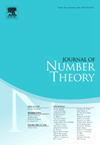具有周期临界点的二次有理函数的伽罗瓦理论
IF 0.7
3区 数学
Q3 MATHEMATICS
引用次数: 0
摘要
给定一个数字域k,一个二次有理函数f(x)∈k(x), k的绝对伽罗瓦群的关联树表示是正则根二叉树的自同构群的子群。Boston和Jones推测,对于f∈Z[x],这样一个表示的像包含一个密集的固定元素集合。当n趋于无穷时,如果自同构在树的第n层上的轨道数仍然很小,则该自同构就成立了。在这篇文章中,我们展示了许多二次有理函数,其相关的树伽罗瓦群不是密集的。这些例子来自于临界点位于单一周期轨道上的二次有理函数。为了证明我们的结果,我们对f的迭代单群(IMG)进行了详细的研究,这也使我们能够对Jones和Levy关于固定对的问题提供否定的答案。进一步,我们研究了由相邻于k(t)的fn(x)=t的所有根(n≥1)对参数t产生的迭代扩展k(f−∞(t))。我们称k(f−∞(t))与k¯的交集为与f相关的常数域。当f的两个临界点之一是另一个临界点的像时,我们证明了常数域包含在由所有单位的2次方根产生的k的环形扩展中。特别地,我们证明了Ejder、Kara和Ozman关于有理函数1(x−1)2的猜想。本文章由计算机程序翻译,如有差异,请以英文原文为准。
Galois theory of quadratic rational functions with periodic critical points
Given a number field k, and a quadratic rational function , the associated arboreal representation of the absolute Galois group of k is a subgroup of the automorphism group of a regular rooted binary tree. Boston and Jones conjectured that the image of such a representation for contains a dense set of settled elements. An automorphism is settled if the number of its orbits on the nth level of the tree remains small as n goes to infinity.
In this article, we exhibit many quadratic rational functions whose associated Arboreal Galois groups are not densely settled. These examples arise from quadratic rational functions whose critical points lie in a single periodic orbit. To prove our results, we present a detailed study of the iterated monodromy groups (IMG) of f, which also allows us to provide a negative answer to Jones and Levy's question regarding settled pairs.
Furthermore, we study the iterated extension generated by adjoining to all roots of for for a parameter t. We call the intersection of with , the field of constants associated with f. When one of the two critical points of f is the image of the other, we show that the field of constants is contained in the cyclotomic extension of k generated by all 2-power roots of unity. In particular, we prove the conjecture of Ejder, Kara, and Ozman regarding the rational function .
求助全文
通过发布文献求助,成功后即可免费获取论文全文。
去求助
来源期刊

Journal of Number Theory
数学-数学
CiteScore
1.30
自引率
14.30%
发文量
122
审稿时长
16 weeks
期刊介绍:
The Journal of Number Theory (JNT) features selected research articles that represent the broad spectrum of interest in contemporary number theory and allied areas. A valuable resource for mathematicians, the journal provides an international forum for the publication of original research in this field.
The Journal of Number Theory is encouraging submissions of quality, long articles where most or all of the technical details are included. The journal now considers and welcomes also papers in Computational Number Theory.
Starting in May 2019, JNT will have a new format with 3 sections:
JNT Prime targets (possibly very long with complete proofs) high impact papers. Articles published in this section will be granted 1 year promotional open access.
JNT General Section is for shorter papers. We particularly encourage submission from junior researchers. Every attempt will be made to expedite the review process for such submissions.
Computational JNT . This section aims to provide a forum to disseminate contributions which make significant use of computer calculations to derive novel number theoretic results. There will be an online repository where supplementary codes and data can be stored.
 求助内容:
求助内容: 应助结果提醒方式:
应助结果提醒方式:


